
How Emmis Changed Radio with Drupal

At Acquia Engage 2016, I enjoyed a wonderful opportunity to share a conversation with the Emmis Radio digital team, Jeffrey Thacker, VP of Digital Content at Emmis Communications and Tat Wza, Site Manager of InFlexWeTrust.com. Our conversation covered how they leverage digital media to reach, grow, engage, and monetize their audiences across 20 radio stations.
The full panel is in the embedded video at the end of this post, but here are some key takeaways from the panel and the backstory on how this all came about.
Why is Emmis Radio important?
As the Media and Entertainment Director, one of my first responsibilities when I arrived at Acquia was to ensure that we attracted strategic industry targets. Media brands like Emmis Communications, Cox Media Group, Cumulus Media, Entercom Radio, and iHeartMedia needed to be on the list.
These are the top 5 pure play radio station companies, meaning that they are not owned by larger conglomerates.
In July of 2013 an Acquia sales rep informed me that we had lost the opportunity to replatform Emmis and the digital extensions of their 20 radio properties away from a homegrown CMS that had been sold off to a third party. Emmis is a leader in broadcast. For instance, in the New York City market, Emmis is most known for offering the first all “hip hop” radio station in the U.S., Hot 97 FM. I knew that Emmis needed to be with Acquia and Drupal, so I was persistent and eventually we won the deal.
Media industry segments tend to have tight nit executive communities. There are even trade associations, like the National Association of Broadcasters (NAB), and sub committees of such associations that focus on digital media. So you can expect that one executive at one broadcast media company will talk to another about their platform decisions.
Without winning Emmis, I do not believe Acquia would have not been able to grow our presence in the US Radio industry. They certainly influenced a few other major broadcasters to join Acquia, namely Entercom Radio and iHeartMedia.
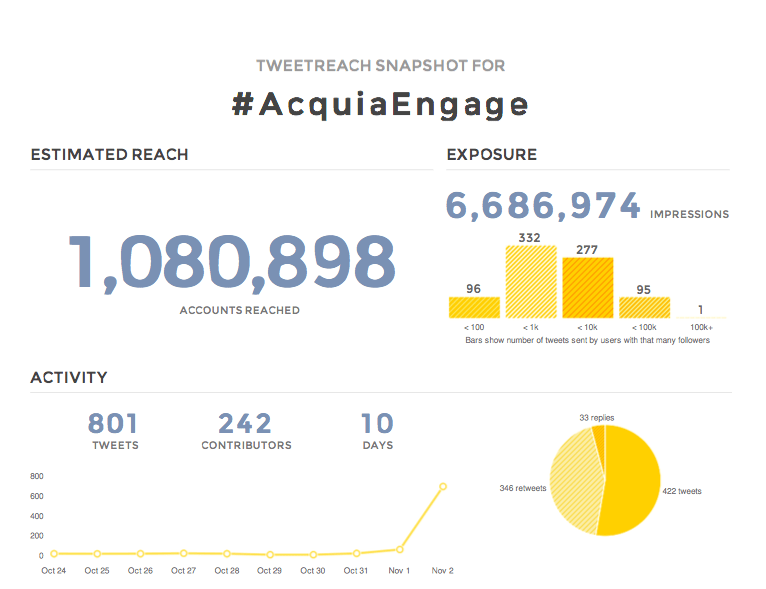
The Reach of Emmis
I quickly realized the impact that Emmis radio brands has across media platforms thanks to a single tweet during the Engage conference.
Below is a TweetReach report that details the size of the Twitter audience that saw the #AcquiaEngage hashtag.
We asked that conference attendees and social media accounts use that hashtag to promote our customer conference, Acquia Engage.
A tweet reach report on November 2nd at Acquia Engage, on the success of the conference hash tag
When I ran the report during day one of the conference, I discovered that via Tweets and retweets, over 6.6 million Twitter users were presented tweets containing the #AcquiaEngage hashtag.
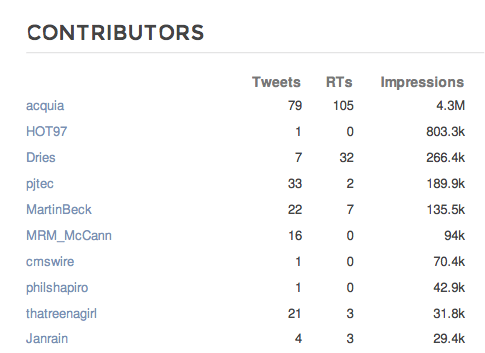
A closer look will tell you that just one tweet from Hot97 with the #AcquiaEngage hash tag gave us 800K impressions.
Acquia got us 4.3 million of that 6.6 million Twitter audience, but it took a lot of tweeting. In fact 79 tweets by Acquia were retweeted 105 times by other users.
So the Twitter audience of just one Emmis Radio stations - Hot97 - can extend the reach of the Acquia brand significantly.
You can imagine that ad sponsors want to tap into this audience that spans the multiple digital media channels Emmis manages.
In fact, Tat Wza is so engaged with his own digital media accounts that he was Snapchatting our panel at the start of our discussion.
Why Emmis Needed a New Platform and How They Chose One
We talk a lot about the Gartner Magic Quadrant for WCM (web content management), and where Acquia falls in the world of WCM platforms. We talk about Adobe and Sitecore, how we are competing with those platforms, but in the media world, those aren’t really the platforms that have been used.
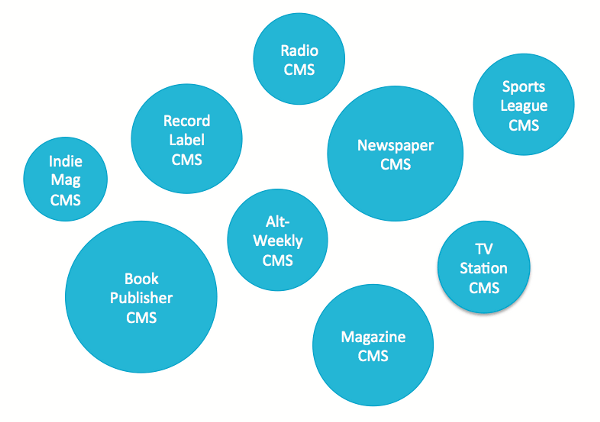
Media companies have specific content production and distribution needs. If it’s a book publisher or newspaper brand, there’s a concern about how content is also arranged and laid out for print. If it's a sports league, there's obviously a lot of sports stats to display and distribute.
When media companies first went digital in the late 90s, customized proprietary CMS solutions tailored to specific segments of the media were developed, and for a long while they fulfilled detailed industry led requirements.
Starting in 2006, the second wave of digital development was driven by a need to integrate emerging social media platforms, like MySpace and early Facebook, or build custom social communities, video, and commenting systems. Today, the Gartner Digital Marketing Transit Map shows you all of the integrations required to deliver a digital experience.
Areas of integration span from mobility to advertising technology, creative content production, video, commerce, data, and audience management.
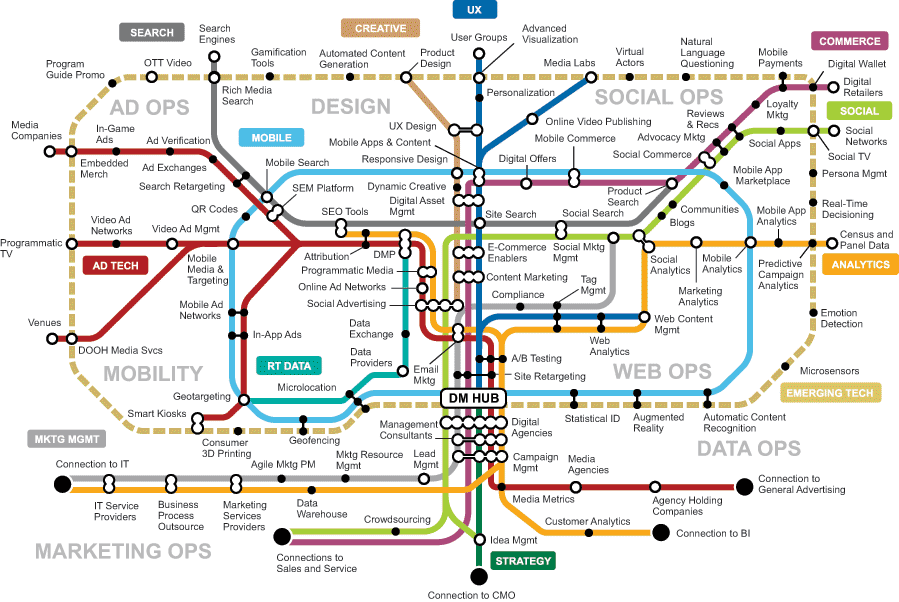
Specialized media CMS vendors could not keep up with the pace of developing integrations for the multiplying digital media services. This spawned a third wave of media industry CMS adoption where companies using specialized CMS vendors moved to future proof and mainly open source solutions.
Industry consolidation across all sectors of media - mainly TV, radio, and newspapers - meant that sometimes a media company would find themselves with 3-4 different CMS solutions across their brands after a few mergers. The need to consolidate platforms was another key driver of this third wave of media company CMS adoption.
Emmis on Choosing a New Digital Platform
Jeff Thacker: We were on our own digital platform at that point. We were running asp.net, but the problem was the world was really enclosed where SEO (search engine optimization) just was not our friend with that old platform. It was almost creating the website inside of a box and telling people to find us the best way you can.
From that moment, we decided that it was important to find a platform that was friendly to SEO, and mobile responsive. I mean the old site was beyond responsive – the entire site. Some of the site was still running on Flash believe it or not, which is painful, but I think once we identified that moment we then created a task force to approach how to find a new platform.
The task force was a cross-functional team. Everyone really worked closely together. Half of the team was broken off into the technical side as far as does a platform makes sense for today’s build and for future projects also. We didn’t want to get stuck inside of a platform, whereas the platform is not evolving the way we are evolving. We left the platform because we were moving at such a fast pace as far as producing content. For instance, for Hot97 we are at 100 posts a week, minimum 20 videos a week – it’s just a beast of a machine that goes on. I can’t even begin to tell you about social.
Chuck Fishman: I could imagine some argument scenes in backrooms. Especially if someone comes in, “Yes, I’ve used Adobe.” or “I know WordPress.” Or - were there some heated discussions or…? v
Jeff Thacker: Definitely some heated discussions - not that heated. Of course, the monkey in the room would be everyone was familiar with WordPress. So, you tend to go with what you know. The rule was, let’s not just say we want something. Let’s make it a good argument, and create a real checklist of “Here’s what we currently have, here’s where we want to go, and then just check off everything that met that need,” and that’s how we got here.
Audience member: Behind the scenes, you mentioned a task force, that you need to get a task force for the whole re-platform and everything. How did your team have to change after this? Because you introduced a complete different way, so you also cannot go back to how you were structured before. What were the types of changes? You also had mentioned training, and also around these websites, do you manage all of them and how do you take care of the politics behind it?
Jeffrey Thacker: The company structure has remained the same. That’s an important dimension. If you find yourself switching platforms of a website, and then everything goes crazy, that means the strategy was already gone a long time ago. The only thing we’ve changed once we switched platforms was the idea on how do we push content out and what that process was.
Chuck Fishman: I think you hired a lot more, for instance, digital staffers ...
Jeffrey Thacker: Yes. We hired more bloggers to come in and produce more concepts because now we have a little more of a robust website. It’s more active but with that, it’s important that we keep the engine flowing. We have up-to-date content coming out all the time. I, myself, I’m in-charge of all of the markets and content. Before this, I was very localized so what we’re doing now, we’re doing market trips across the US and re-identifying a good strategy.
Leveraging the Power of a New Platform
Chuck Fishman: What does a digital producer do at Emmis? I guess it’s a part of the production job, but what are some of the producers doing? What kind of content are they making?
Jeffrey Thacker: Yes. At Emmis, we have digital producers. Our digital producers are the ones that are creating our stories on a day-to-day basis. It’s split into two folds; they sit in the studios with our personalities and they create amazing articles and relevant articles, and they also share items to social media channels and the way we look at it is as a solid ecosystem. We talk a lot about the separation and sometimes, digital growth facet in the actual terrestrial part, but that’s still the core business. So the core business is the radio, so we want to make sure we treat the company as an ecosystem where our digital approach is still serving back to the terrestrial and vice versa.
Chuck Fishman: How do you do that? How do you drive digital to say, “Okay. I want you on the terrestrial channel”?
Jeffrey Thacker: Yes, yes. I think part of it – well, I could probably come back to it, but a lot of it, we tell people if there’s an amazing interview coming up, or on social media, we might be teasing something that just happened around the world. So, our end-studio producers are notifying the jocks on air like, “Hey, this is just now breaking.” There, we have the story live on a website. On social media, we’ve communicated a “tease” to drive back to our website as well, and if sometimes we may have an exclusive interview to tie-in to it. So, we’re looking at is as a world with multiple touch points, where we’re engaging with our listeners, and engaging them back to our website as well.
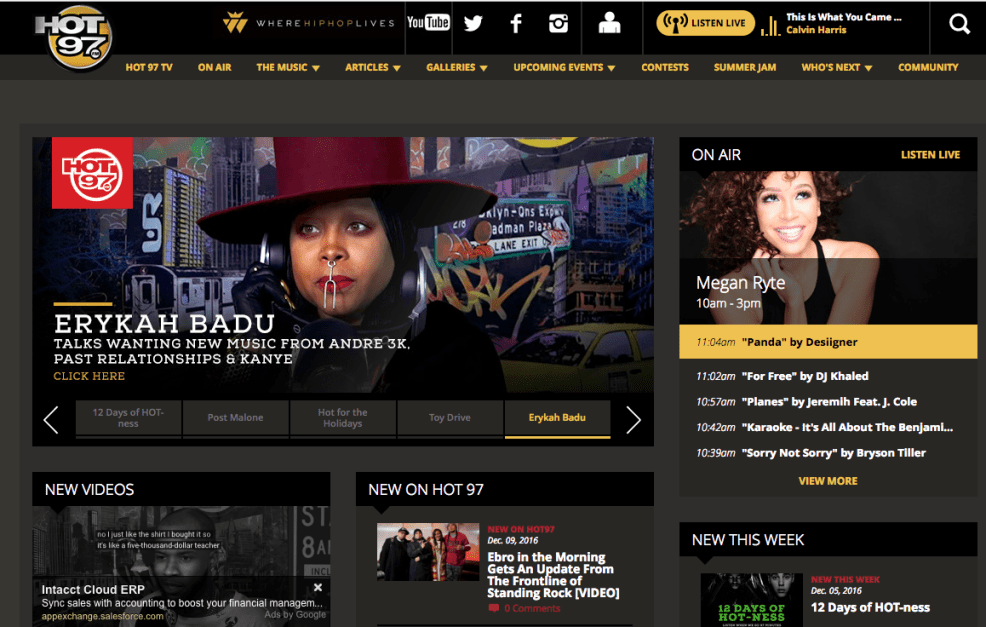
Chuck Fishman: What type of content your team produces is the most engaging?
Jeffrey Thacker: Ideally, never stray away from what you’re known for. We’re known for music and we’re going to give people a great music experience. Right now, freestyles are doing amazing.
Chuck Fishman: So freestyle rap? You mean somebody coming on…?
Jeffrey Thacker: Yes, a rapper comes into the station, and on air they do a freestyle rap. A great example was –
Tat Wza: Meek Mill. Yes, a Philly based rapper, he got 3.5 million views on YouTube for his Hot97 Freestyle. We got to that number of views in about two and half weeks.
Chuck Fishman: Then, you embed YouTube video on your site?
Jeffrey Thacker: Yes. The process on that one is interesting. There’s a little story behind it. We were at a YouTube event that same night, I get a call from Flex saying…
Chuck Fishman: Flex being your on-air host from Hot97.
Jeffrey Thacker: Yes. He goes, “Tonight.” It sounded like a wrestling match. It was like, “Tonight.” I was like, “Okay – what?” He’s like, “We need someone to film this tonight.” So, I had two amazing video guys with me that went out to bat on that.
Tat Wza: Nothing was on the schedule. I produce Flex’s run, and I had even taken off to go to a tech event, and he called me up too. He said, “Hey, you got to come back. I’m going to call Jeff now.” I said, “All right,” and he got it.
Jeffrey Thacker: All of this is the urgency and how timely content is and why it’s important to have a great platform to do it on. The team went there, they shot it. I’m not going to say how long it took them, but it’s a long night.
Tat Wza: A couple more minutes than the actual freestyle.
Jeffrey Thacker: Yes. It takes - the shooting and then the editing, they worked overnight, and then we planned it really well. The host made an announcement that the freestyle would be available at a certain time on social media, that drove social engagement. When we finally went live with it on the site, the analytics say per second, it was about 2,500 people per second visiting hot97.com just to obtain the content itself, which is great.
Right now, we monetize our YouTube account. I think most major companies are monetizing that. We’re in the top 5% on YouTube sales. We’re able to sell against our YouTube content as well, which is great for us, but our listeners and our fans and just the age itself do not like spending money for content like that so ad supported content is the best way to go. We’re in year five now of doing live streaming, so we live stream Summer Jam as well.
Engaging the Audience with New Technologies and New Formats
Chuck Fishman: On a positive note, I think one of the things you guys did develop with the platform in your agency partner and on Acquia is a user-generated content platform. Can you tell us with that function, what that serves, and what it does?
Jeffrey Thacker: Yes – our UGC platform is doing really well.
Chuck Fishman: UGC, being user-generated content?
Jeffrey Thacker: Yes, yes, yes, yes.
Chuck Fishman: Acronym alert.
Jeffery Thacker: [Laughter] Alert. We do a lot of contesting on the platform now. I’m trying to remember the most recent one we had, but - oh, yes. We’re running one on our New York based R&B station, WBLS, right now, actually. We’re soliciting for church choirs to submit an under two minute video of them and their church performing, and they’re submitting to wbls.com.
Jeffrey Thacker: Before we a had a third-party company which was super clunky, and it’s always hard to have a product like a UGC product, whereas the third-party ones require you to have an iframe. So you’re iframe it into your website, and I saw a lot of eyes pop up. I said the “iframe” word. Yes. You had to drop it in there, then that iframe also has its own username and password which is completely separate from your own website. I was getting calls at one point that said, “Hey, I just logged-in but I don’t see my profile.” Like, “Where did you log-in at?” The worlds are so separate. So this new ecosystem where we have built our own UGC system that integrates with the CMS, it helps us create a better user experience.
Chuck Fishman: Right. So they’re going their own Drupal user profile when they submit their user content?
Jeffrey Thacker: Correct. I think that’s the important part.
